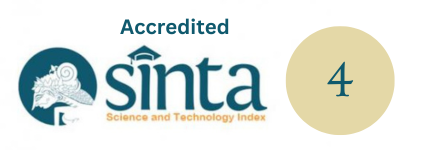Sangkameteng Karawitan Composition | Komposisi Karawitan Sangkameteng
DOI:
https://doi.org/10.59997/jurnalsenikarawitan.v1i1.212Keywords:
Sangkameteng, Selonding, Bedug, RenonAbstract
The purpose of making this artwork is to convey a moral message to the public about the importance of preserving a local wisdom that has developed in Desa Adat Renon (Traditional Village), Renon Village, South Denpasar through a new youthful and contemporary spirit musical artwork. The composer created stages of Sankameteng artwork inspired from the Alma M. Hawkins concept presented in his book Creating Through Dance. He stated that the creation of an artwork was taken through three stages, namely the exploration, improvisation and the forming stage. Related to the artwork media, the composer used Wesi Cwaram's gamelan as the implementation of the ideas and concepts. Gamelan Wesi Cwaram is a new gamelan ensemble that emerges after the development of the Selonding gamelan. Sankameteng karawitan artwork uses parts that are arranged according to the atmosphere to be achieved. A series of scenes from a dusk state called sandikala (nightfall) and memeteng (in the dark) as a result of ngaturang procession presented in the song structural parts, divided into three parts, namely, part I, part II, and part III. Academic artists are artists who have more abilities in their fields, especially in academic matters. As an academic artist, one should be able to contribute and be dedicated to society.
Downloads
References
A.A.M.Djelantik. 1999. Estetika: Sebuah Pengantar. Bandung: Masyarakat Seni Pertunjukan Indonesia (MSPI).
Arya Sugiartha. 2012. Kreatifitas Musik Bali Garapan Baru Perspektif Cultural Studies. Denpasar: UPT Penerbitan ISI Denpasar.
Aryasa, IWM W.M. Dkk. 1985. Pengetahuan Karawitan Bali. Denpasar: Departemen Pendidikan dan Kebudayaan Bali.
Bandem, I Made. 2013. Gamelan Bali Diatas Panggung Sejarah. Denpasar: BP. STIKOM BALI.
Banoe, Ponoe. 2003. Kamus Musik. Yogyakarta: Kanisius.
Hardjana, Suka. 2011. Corat-Coret Musik Kontemporer Dulu Dan Kini. Jakarta: Ford Foundation.
I Wayan Rai. 1996. “Balinese Gamelan Gong Beri.” Mudra 4(4).
Pradnyantika, I Gede Aguswin, I Nyoman Sudiana, and Tri Haryanto. 2019. “Waluku Sebagai Acuan Dalam Garapan Karawitan Bali.” Kalangwan 5: 49–60.
Santosa, Hendra. Nina Herlina Lubis., Kunto Sofianto, RM. Mulyadi, and Hendra Santosa. 2017. “Seni Pertunjukan Bali Pada Masa Dinasti Warmadewa.” MUDRA Jurnal Seni Budaya 32(1): 81–91.
Santosa, Hendra; Saptono. 2016. “Gamelan Sistem Sepuluh Nada Dalam Satu Gembyang Untuk Olah Kreativitas Karawitan Bali.” Pantun 1(2): 85–96. https://jurnal.isbi.ac.id/index.php/pantun/article/view/747.
Santosa, Hendra. 2017. “Gamelan Perang Di Bali Abad Ke-10 Sampai Awal Abad Ke-21.” Sumedang: Universitas Padjadjaran.
———. 2019. “Kajian Historis Tentang Gamelan Ketug Bumi.” Mudra Jurnal Seni Budaya 34(1): 36–44.
Tusan, Pande Wayan. 2002. Selonding: Tinjauan Gamelan Bali Kuna Abad X-XIV, Suatu Kajian Berdasarkan Prasasti, Karya Sastra, Dan Artefak. Karangasem: Citra Lekha Sanggraha.
Widiana, I Wayan Pande. 2019. “Karakteristik Gamelan Selonding Bebandem Dan Selonding Tenganan ‘Studi Komparasi Intramusikal.’” Mudra Jurnal Seni Budaya 34(1): 61–72.








